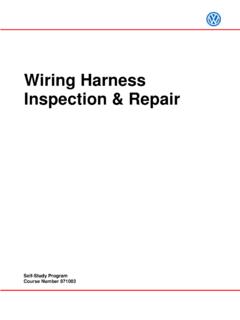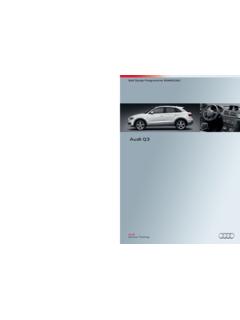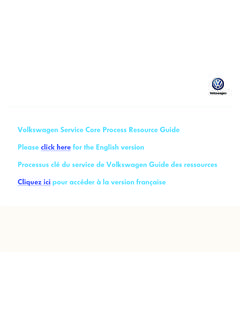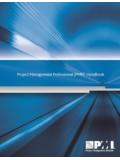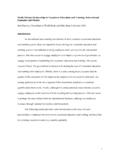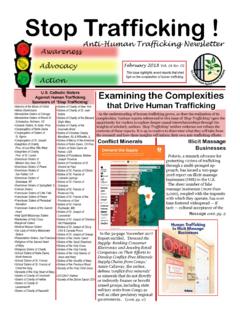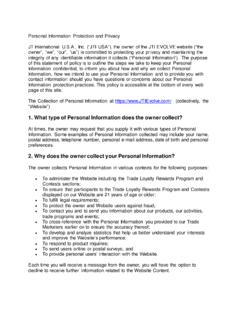Transcription of Self-Study Program 871803 - DataRunners
1 Service TrainingSelf- study Program 871803 Occupant Protection SystemsVolkswagen Group of America, Inc. Volkswagen Academy Printed in Printed 10/2008 Course Number 871803 2008 Volkswagen Group of America, rights reserved. All information contained in this manual is based on the latest information available at the time of printing and is subject to the copyright and other intellectual property rights of Volkswagen Group of America, Inc., its affiliated companies and its licensors. All rights are reserved to make changes at any time without notice. No part of this document may be reproduced, stored in a retrieval system , or transmitted in any form or by any means, electronic, mechanical, photocopying, recording or otherwise, nor may these materials be modified or reposted to other sites without the prior expressed written permission of the requests for permission to copy and redistribute information should be referred to Volkswagen Group of America, check Technical Bulletins and the latest electronic repair information for information that may supersede any information included in this.
2 All brand names and product names used in this manual are trade names, service marks, trademarks, or registered trademarks; and are the property of their respective .. 2 Basic Concepts .. 6 Passive Occupant Protection Systems .. 16 Knowledge Assessment .. 75 This Self-Study Program covers information on the Volkswagen Occupant Protection Self-Study Program is not a Repair Manual. This information will not be testing, adjustment and repair procedures, always refer to the latest electronic service !2 IntroductionOccupant Protection SystemThe overall occupant protection system is sub-divided into the two categories of active and passive safety.
3 The following overview is intended to show which safety elements are assigned to active and which to passive occupant SafetyActive safety encompasses everything that may contribute toward preventing accidents wherever possible. This includes direct and comfortable steering, good engine/transmission characteristics and coordination, good traction, and effective seats, clear visibility, good climate control plus clear and uncomplicated controls and displays help to maintain the driver s active safety systems include the following systems, for example:A nti-lock Brake system ABST raction Control system TCSE lectronic Stabilization Program ESPE lectronic Brake Distribution EBDA daptive Cruise Control ACCE lectronic Differential Lock EDL3 Introduction3 Passive SafetyPassive safety refers to all design engineering measures which serve to protect vehicle occupants from injury and to minimize the risk of injuries in the event of an term particularly refers to crash behavior and gives consideration to both personal protection and the protection of other road users in the event of an most important passive safety features in modern vehicles include.
4 The safety belt system with safety belt pre- tensioners, including child restraint systemsThe airbag system , consisting of front, side and Side Curtain Protection airbagsA rigid passenger compartment with corresponding roof stiffness plus crumple zones in the front, rear and side areas (these protect occupants by dissipating impact energy)Roll-over protection for convertibles Battery interrupter devices 4 IntroductionGeneral outline of Safety Belt and Airbag system Development in AutomobilesSafety Belt Development Back in 1903, Frenchman Gustave Desir Lebeau patented a safety belt, in the form of a shoulder belt which was worn crossways.
5 However, safety belts were not generally available until 1957. Initially installed only at the front, these were still pure lap belts, which held the body in the seat in the pelvis area. The upper body was not held in the seat, and was not protected against a frontal crash. In 1958, Nils Bohlin patented the first 3-point safety belt. In 1959, the first automobile manufacturer fitted these safety belts as standard. With the 3-point safety belt, the entire upper body was restrained. Initially, these belts were still static and did not adapt to the body of the wearer. The safety belt system was enhanced by head restraints, which were first implemented in 1968.
6 The neck area was protected against overstretching during occupant movement to the rear after a crash and also in the event of rear impact. The launch of the automatic retractor in 1969 meant that the safety belt was retracted under spring force and always adapted itself to the wearer. In 1979, comfort of the safety belt on vehicle occupants bodies was improved by the new shoulder height adjustment feature. This enabled the upper anchorage point on the vehicle body to be adjusted so that the belt routing adapted very well to the wearer s size. In 1980 in combination with a driver airbag a safety belt pre-tensioner was introduced for the first time on the front passenger seat.
7 In the event of an impact, this tensioned the belt and ensured that the safety belt was positioned taut against the wearer s body. The system was additionally enhanced by belt tension limiters (safety belt loops, torsional limiters).1957195919681969 Lap Belts (static belt)3-Point Safety Belts (static belt)Front Head RestraintsAutomatic Safety Belt Retractor5 Introduction5 Airbag Development A patent for an airbag was first registered in Germany by Walter Linderer in 1951. The patent was issued in 1953. It was only later from 1980 onwards that the first airbag was fitted as standard in an automobile (starting in the USA).
8 High-volume airbags were used in the USA, as the wearing of safety belts was not a legal requirement in many states. In Europe, lower-volume airbags were used, as safety belts were required to be worn by law. Airbags for the driver were introduced first, followed by passenger airbags. To protect against lateral impact, side airbags were introduced in 1994. Depending on options selected, these were installed for the front and also the rear seats. This lateral protection was subsequently extended to the upper areas of the body. A side curtain airbag was developed to achieve this. This stretched across the length of the window and protected the head area.
9 Today, airbag development is focused on deployment strategies, occupant position detection, and the unfolding of the airbag in order to reduce the risk of Height AdjustmentFront Airbags Driver Airbag, Safety Belt Pretensioner Front Passenger SideSide AirbagsSide Curtain ProtectionNever rely on airbags alone for protection. Even when they deploy, airbags provide only supplemental protection. Airbags work most effectively when used with properly worn safety belts. Therefore, always wear your safety belts and make sure that everybody in your vehicle is properly !Basic Concepts6 Passive Occupant Protection system Body design Airbags Safety belts Safety belt pre-tensioners Safety belt tension limiters Seat design with active head restraints Child restraint systems Battery interrupt devices Control module and sensorsModel-specific information on the airbag systems can be found in the relevant Self-Study illustration shows a general example of a vehicle s passive occupant protection equipment.
10 Different variations are possible depending on vehicle model and Crash SensorsAirbag Control ModuleFront Passenger AirbagFront Passenger Side AirbagRight Side Curtain ProtectionBasic Concepts7 Driver Side AirbagFront Side Airbag Crash SensorSafety Belt Pre-TensionerDriver AirbagRear Side Airbag Crash SensorLeft Rear Side AirbagRight Rear Side AirbagLeft Side Curtain ProtectionFor reasons of clarity, the right-side crash sensors and safety belt pre-tensioner are not shown in the Concepts8 system Component NetworkingThe passive safety system consists of the following components:Airbag control module Driver and front passenger airbags Side airbags driver and passenger Side curtain protection Crash detection sensors Safety belt pre-tensioners Belt tensioner limiters Rollover protection for convertibles Battery interrupter elements (only in vehicles in which the battery is installed in the interior/luggage compartment)


